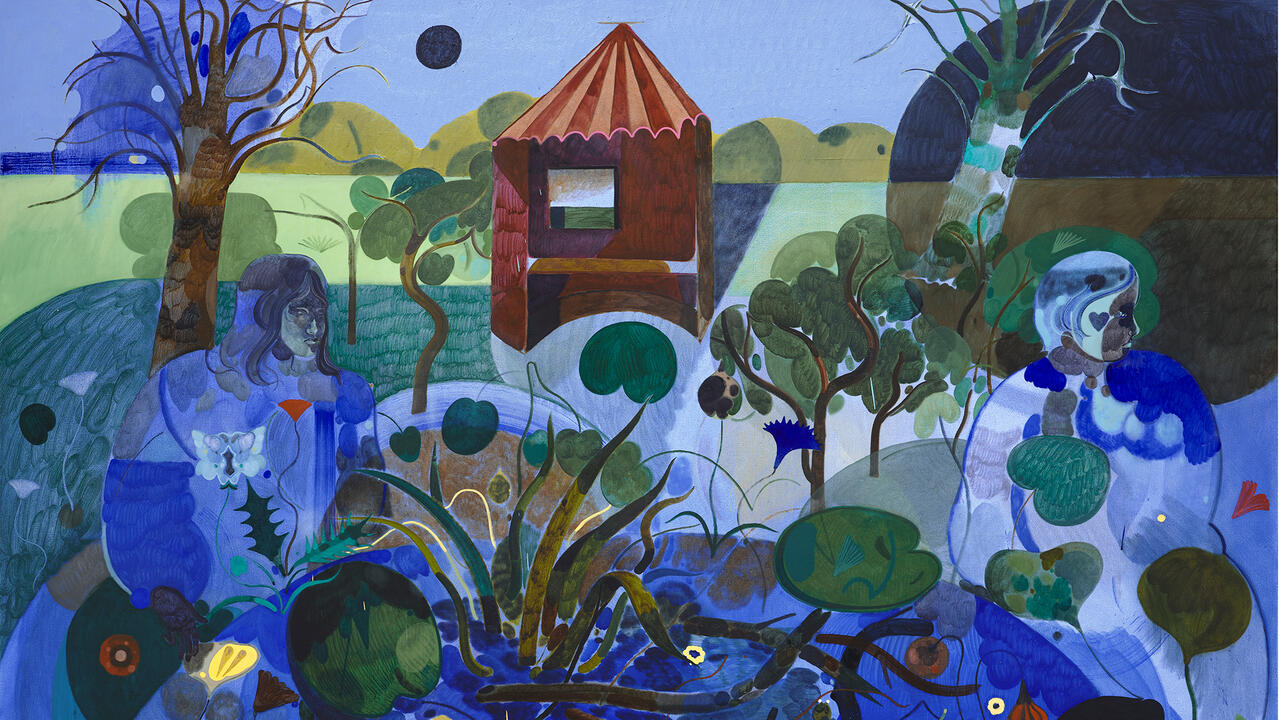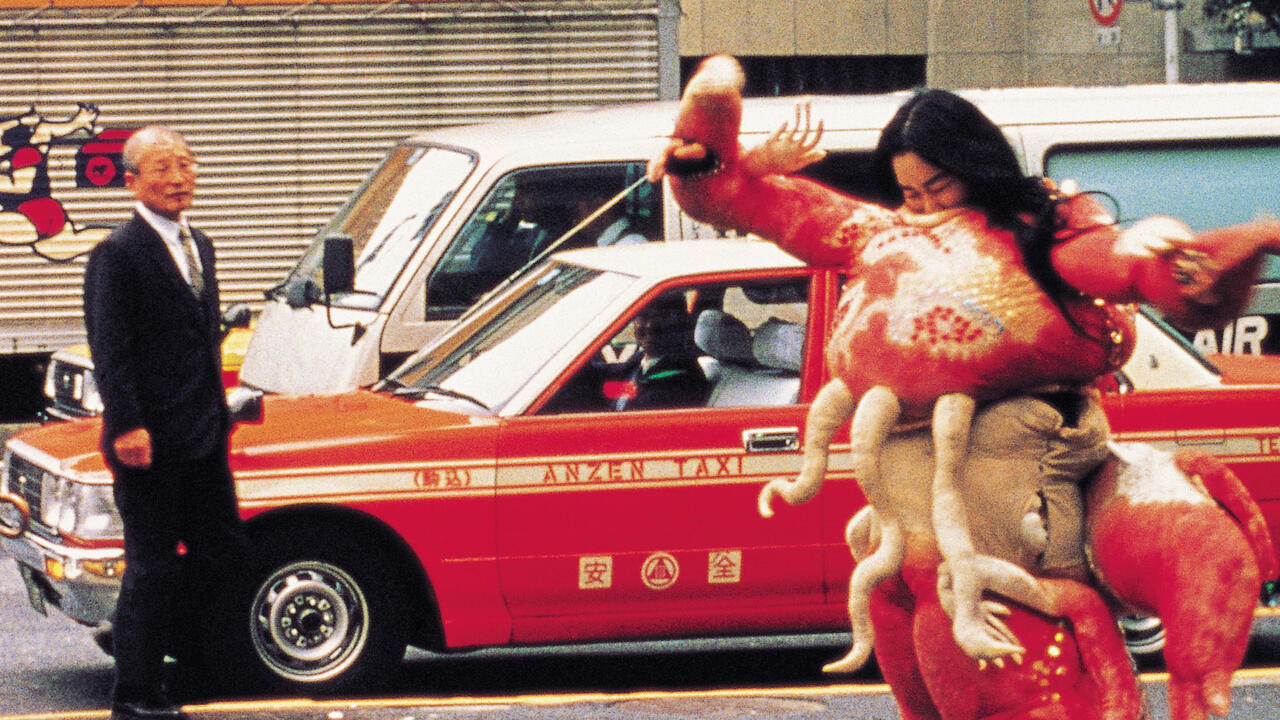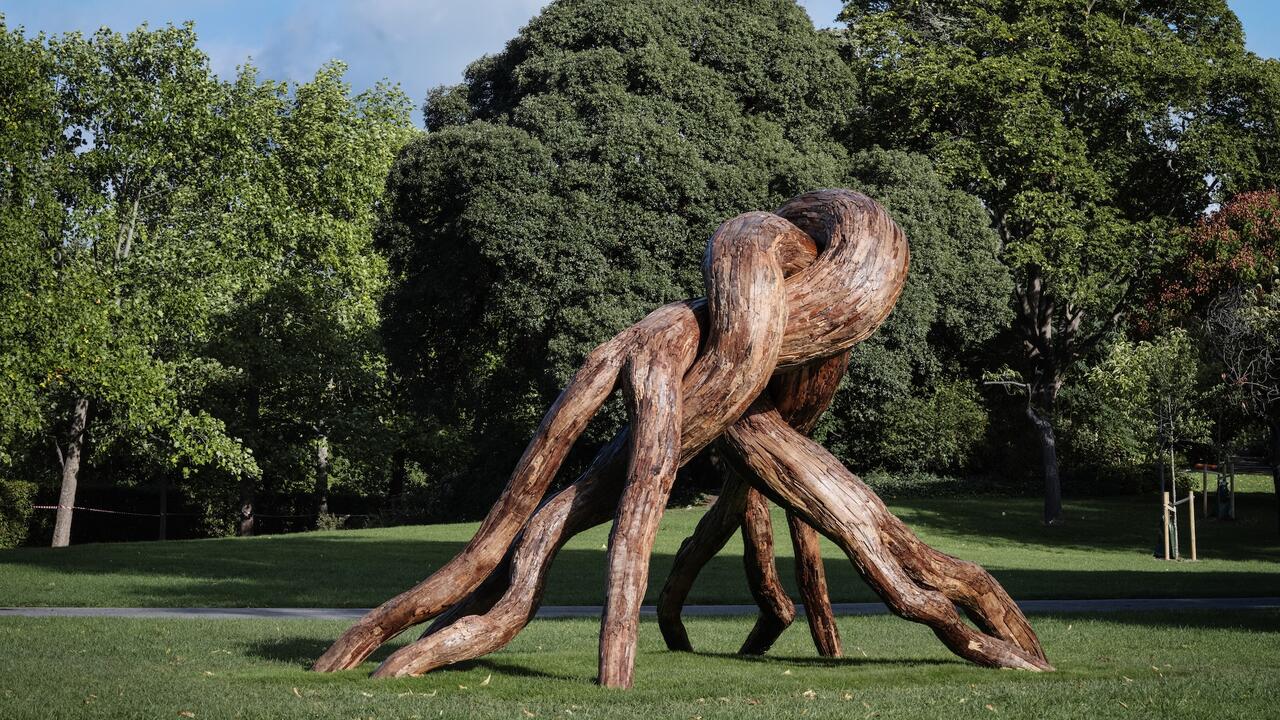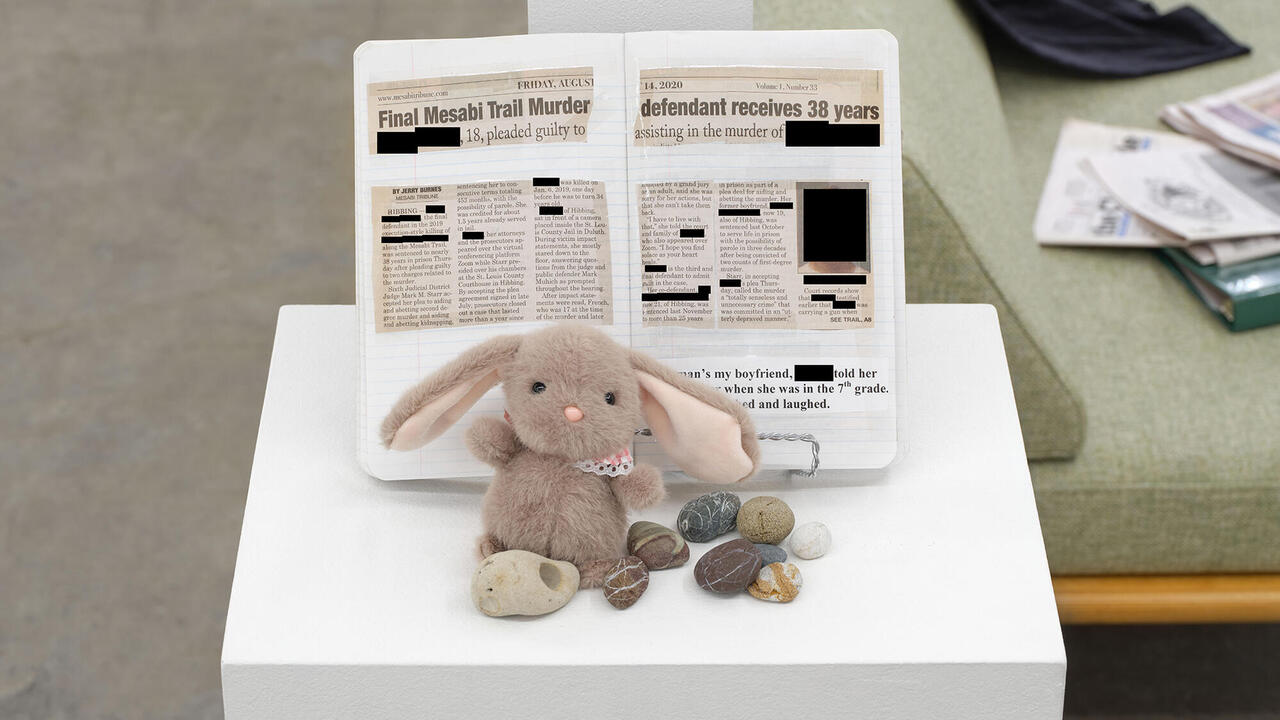Back to the Future
Alternative histories and playful anachronisms shape Steven Claydon’s sculptures, paintings and videos
Alternative histories and playful anachronisms shape Steven Claydon’s sculptures, paintings and videos

Napoleon Bonaparte triumphs at Waterloo in 1815 and is crowned Universal Monarch. Martin Bormann succeeds Adolf Hitler as Führer in 1948 and two decades later puts the first Nazi on the moon. The Crystal Palace burns down in Hyde Park, London, in 1984. Among the items destroyed in the fire is the Bayeux Tapestry.
These events belong not to the past but to speculative fiction.1 Since at least Livy’s Ab urbe condita (From the Founding of the City, 27–25 BC), in which the Roman historian explores a ‘what if?’ scenario in which Alexander the Great attempts to invade the Eternal City, scholars and storytellers have offered visions of the world as it might have been but never was. Although these counter-factual narratives may be presented as thought experiments, they’re usually conducted with an eye not to dispassionate inquiry but rather to dramatic effect, or to the shoring up of political power – unsurprisingly, Livy averred that ‘The aspect of Italy would have struck [Alexander] as very different from the India which he traversed in drunken revelry with an intoxicated army’ and had the Roman army dispatch the upstart Macedonian post-haste. And yet, if these tales of what did not happen are beset with bias, so too are tales of what did. Importantly, when words or images or objects summon up a past, they also summon up a possible future. During preparations for his (later aborted) invasion of Britain in 1803, Napoleon ordered the Bayeux Tapestry to be taken from Normandy to Paris so that he might draw inspiration from its triumphalist depiction of William the Conqueror’s defeat of King Harold in 1066. Running his fingers across its warp and weft, its teleological threads, the French emperor might just have been forgiven for thinking that he was touching not a work of art, nor a piece of propaganda, but the very fabric of history itself.
For his exhibition ‘New Valkonia’ at David Kordansky Gallery, Los Angeles, in 2007, Steven Claydon presented a group of artefacts from a fictional Eastern European nation that – with their hints at ritual and scientific rationalism, their veneration of the old and their fervour for the new – straddle an odd classicism and an odder modernity. The artist took his title from a T-shirt he found on a market stall in Warsaw, printed with a picture of a fat man flogging a whinnying horse, and the words ‘Nie Val Konia’ – a phrase that, after numerous flushed-cheeked inquiries, he finally discovered meant ‘Stop Masturbating’. Appropriately, the material culture of this imagined nation suggests a preference for the aggressively productive over the idly pleasurable. A painted screen, Hornets (Mousterians & Moderns) (2007), depicts a Neanderthal hunting party, while two portrait busts, Patrician (male) (Despotism & Tricks) (2007) and Patrician (female) (Anthropods in Arcadia) (2007), bear the images of political leaders, accessorized respectively with a bronze helmet and a Nietzschean moustache, and a sci-fi visor and a haircut that combines the tonsorial virtues of Angela Davis, Princess Leia from Star Wars (1977) and Jacob Epstein’s Portrait of Iris Beerbohm Tree (1915). Other, more mystical, types of potency are suggested by the items arranged on a tripartite light-box: The Ancients Set Great Store (2007), a black, baseball-like seamed orb with cartoonish eyes supported by a complex brass tripod; Chitin & A-Parallelism (New Valkonia) (2007), a gladiator’s helmet with a bin-bag plume and an image of a ZX Spectrum-era computer game monster embossed on its peak; and Valkonian Objects (2007), a group of odds and ends comprising an animal horn, chicken bones cast in metal, pieces of quartz bound with parcel string, and what looks like a scientific model of an elementary particle.
Throughout the show Claydon employed black-painted plinths topped with hessian-covered boxes, a display strategy that recalls both the 19th-century ethnographic museum (all that scratchy sackcloth) and Aby Warburg’s ‘Mnemosyne Atlas’ (1924–9), a series of 79 wooden panels sheathed in black fabric on which the art historian juxtaposed some 2,000 images from his archive, ranging from reproductions of antique sculptures, medieval maps and Renaissance altarpieces to postage stamps, magazine advertisements for cologne and newspaper photographs of Zeppelin airships. But while Warburg’s pictorial constellation challenged the Vasarian, linearly progressive model of art history, each of the images and objects in ‘New Valkonia’ appears already to belong to no specific period, or rather to belong to several periods at once, something that’s born not only of their mixing of (faux-) historical visual registers but also of their evocation of traditional materials through thoroughly modern means – bronze, in these works, is conjured through verdigris-ed copper powder, and marble through polymer ceramic. These are artefacts, then, that are faithful neither to the past (how could they be, when that past is a fiction?) nor to their own apparent chemical make-up. Looking at them, we must seek value elsewhere.
In his novel Ada or Ardor: A Family Chronicle (1969) Vladimir Nabokov introduces us to Anti-Terra, a planet on which portions of 20th-century America are under the control of Tsarist Russia. Here our own planet, Terra, is widely believed to exist, to the extent that some of the inhabitants of Anti-Terra believe themselves to inhabit a hallucination. Unlike The Matrix (1999), a film in which a false reality is revealed as such, Nabokov plunges all apparent realities into doubt – the concept of Anti-Terra, after all, allows for the possibility of an Anti-Ada, a book in which Ada’s Terran readers would feature as characters suspicious, but never quite certain, that their own world was nothing but a dream. ‘New Valkonia’ has a similar effect. This fictional nation reminds us that all nations are to some extent fictionalized, and that art – especially art that makes claim to historical and material ‘truth’ – has often been employed to this effect, while simultaneously carefully covering its tracks. However, Claydon’s work does much more than score an open goal against grand narratives. Rather, it maps out the stratified fictions of episodes of cultural history (some distant, some proximate) in order to approach the perhaps intractable problem of where the ‘artness’ of art resides. Perhaps more than most art of the present moment, it also reflects on how it might be understood in the distant years ahead. This is not to say that Claydon makes a premature claim to his place in art history, but rather that he’s aware that, should his work survive the depredations of human amnesia and material decay, it will one day be a relic of a bygone age, a red herring to be interpreted through unknown meaning-frames and appropriated to unknown ends. Looking at it, it seems to anticipate, with no little mischief, the gentle flicker of the future archaeologist’s brush.
So disparate are the cues and clues in Claydon’s work that there are times when he appears to be developing a body of subterranean knowledge, his own idiosyncratic version of The Da Vinci Code (2003). (Tomorrow’s art historians may find it profitable to locate his practice at the sharp end of the post-millennial trend in popular culture towards occult-tinged conspiracy theory – think of Kate Mosse’s best-selling novel Labyrinth, (2005), or the TV series Lost, 2004–ongoing.) The artist’s recent exhibition ‘A & not A’ at Galerie Dennis Kimmerich, Dusseldorf, is a case in point. Here he took as his departure point Martin Heidegger’s argument, in The Origin of the Work of Art (1935–60), that the ‘truth’ of an art work is a product of a constant and necessarily irresolvable conflict between ‘earth’ (a corollary of existence, or active matter, which can never be wholly understood) and ‘world’ (a corollary of being, or passive context, which can). For Claydon this struggle is exemplified in the Belgian cartoonist Peyo’s strip Les Schtroumpfs (The Smurfs), first published in 1928, in which the magical blue gnomes inhabit a bucolic village in a woodland clearing that is regularly threatened by the alchemist Gargamel’s unsuccessful attempts to find the secret ingredients with which to make gold, one of which he suspects is his enemies’ cerulean flesh. The Smurfs, of course, all sport Phrygian bonnets, floppy hats that denoted to the Greeks barbarism and to the Romans and the Jacobins liberty. Heidegger, a German nationalist, was known as ‘Stocking Cap’ because of his adoption of the headgear of the Alemannic peasantry, and Peyo named his forest-dwelling creations after the German word for ‘sock’ or ‘stocking’, in mockery of Teutonic Romanticism. The current holders of The Smurfs’ copyright are markedly less playful. Unamused by the Armenian-born, Germany-based middleweight boxer Arthur Abraham’s habit of entering the ring wearing a gold Phrygian bonnet and jiving to Father Abraham’s The Smurf Song (1977), in 2006 they sent him a cease-and-desist letter: a legal action very much at odds with the bonnet’s status as a symbol of freedom. From this network of casual connections – crossing time and place, ‘high’ and ‘low’ culture – Claydon created a series of works in which contradiction is always in play, and in which ‘A & not A’ is the unstable equation that gives objects, images and ideologies a stuttering sort of life.
On the upper level of Claydon’s shelf-like sculpture A lark descending (Preparations for Leda) (2008) a bust of what might be the Greek god Zeus emerges from a cheap plastic bag and sprouts a beak, taking on animal form to carry out his most infamous seduction (birds, for Claydon, are symbols of rapacious self-interest). Beside it sits a steel I-beam remade in ceramic – an object that converts an piece of Modernist functionality into a fragile, functionally useless work of art. On the lower level a draughtsman’s tool is held in a clamp, a length of yellow hose is coiled like a sleeping snake and a modest piece of plywood is presented as though it were a valuable relic. The common ground here is partial transformation and a strange kind of impotency. Given the shape of many of the objects, we might identify them as phalluses that are both ‘A & not A’, belonging to neither the limp Apollo nor the priapic Dionysus, a reading supported by the acrylic and ink study Apollonian Self-Abnegation (2008), in which a wary-looking caveman with a lyre-strumming mantis perched on his shoulder contemplates a burning, soon-to-melt candle, as though on the precipice of renouncing his various atavisms and stepping into the sun god’s neutering light. Masculinity and its uncertainties also haunt Obst (2008), a bronze foot and foreleg wearing nail polish and a gladiatorial sandal formed from leather straps and footballer’s shin-pad of contemporary design. The work obliquely refers to the furore among fans of Southampton FC when an 11-foot bronze public sculpture of their legendary manager Ted Bates was unveiled in March 2007, only to reveal that its separately cast head, arms and legs were hilariously out of proportion and that its face, modelled from photographs, more closely resembled the former owner of rival Portsmouth FC, Milan Mandaric, than the local hero. (The statue, which conspicuously lacked the Heidegger-approved combination of ‘earth’ and ‘world’, was soon taken down and broken into pieces.) We might also interpret Obst as the single sandal lost by the swollen-footed Oedipus, an absence that would mark him out as destined to kill his father and make love to his mother. In this piece transformation – of life into art, of a boy into a man – is achieved at the expense of the Classical physical ideal and results in both comedy and tragedy.
Nearly every work in ‘A & not A’ featured a particular Smurfy-blue, from the plastic bag and nail polish in A lark descending … and Obst to Stocking Cap in Bucholia (2008), a found photograph of a Smurf sheltering under a tented copy of Heidegger’s Being and Nothingness (1943), to Phrygian Orchids (2008), a screen print of a bonneted Arthur Abraham, and to the oil barrel (a nod towards Diogenes?) in Elegant (Running Stutter) (2008) – a piece that takes part of its title from a kebab shop on the Hackney Road in London’s East End. The shop’s startlingly unattractive frontage is painted in this shade, which also features on the helmets of UN peacekeepers and the plasters worn by British catering workers to cover an unhygienic piercing or cut. This blue, then, usually signals a zone of pure functionality, a kind of aesthetic zero, something that I suspect Claydon, with his micro-attention to the look and feel of things, would regard as impossible. Images and objects always do more than one job and almost always stumble over the ambiguities this generates. By employing this peculiar shade in ‘A & not A’, Claydon performs a kind of alchemy, transforming – momentarily at least, and unlike the perennially thwarted Gargamel – base matter into something a lot like gold.
Gargamel (or more precisely footage of a Smurfs fan dressed up as him) also features in Claydon’s recent video The Ancient Set (2008), first screened at the International Project Space, Birmingham. A staccato collision of monadic pixels, antique statuary, modern-day men and women in woeful nylon togas and a soundtrack that feeds the score of a composition designed to be played on replica Roman instruments through a slightly outmoded synthesizer, the work is a deliberately unsuccessful, even grotesque, appropriation of Classical culture, which nevertheless points not only to other such appropriations in Western history and to the power structures they supported but also to the wild side of the ancient world that they so often suppressed or denied. Every replay of the past is fated to be flawed (even in the most scrupulous historical re-enactment group there’s always a roundhead in bifocals or a Cicero in socks) and perhaps says more about the time in which it occurs than the time it seeks to evoke. Claydon’s work may do much business with history, but in truth it is about now – a moment built on fictions, and one that will be fictionalized in the years to come.
1 They are taken, respectively, from: Louis Geoffrey’s History of the Universal Monarchy: Napoleon and the Conquest of the World (1836), Philip K. Dick’s The Man in the High Castle (1962) and Bryan Talbot’s The Adventures of Luther Arkwright (1978).

























